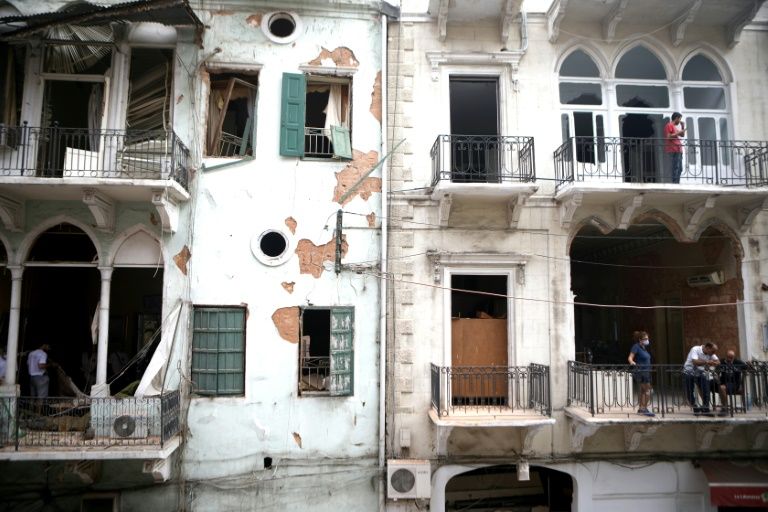The monster explosion that leveled Beirut's port darkened the Lebanese capital's future and blasted its past into oblivion, ravaging many architectural and cultural treasures.
Gems of the city's heritage, including some of the region's most elegant Levantine villas with their triple-arch windows, were damaged beyond repair.
Many of old Beirut's remaining landmarks from the colonial era and even before had already been damaged by 15 years of civil war and decades of government neglect.
The August 4 blast finished the job.
03:18

"It feels like a rape," said Tania Ingea, heiress of a mansion on Sursock Street, a stone's throw away from the site of the mega-blast. The residence houses some of the most striking vestiges of the old Beirut aristocracy's heyday.
The devastating detonation of a pile of industrial fertilizers, widely blamed on government negligence, was so powerful that it literally redrew Beirut's coastline and skyline.
Ingea's converted 18th-century palace now looks like it has been vandalized, with broken Ottoman-era artifacts in every one of both floors' rooms.
Wooden panels inscribed with Arabic calligraphy have been blown off doors and walls and now sit piled in corners of the house.

Damaged buildings featuring traditional triple-arch windows are seen in Beirut's Mar Mikhael neighborhood. /AFP
Damaged buildings featuring traditional triple-arch windows are seen in Beirut's Mar Mikhael neighborhood. /AFP
Shards of stained glass more than two centuries old have been swept aside to one corner with the rest of the waste.
When Lebanon marks its centennial in three weeks, the port blast will have deprived it of some of the most graceful relics of that period.
"There is now a cut between the present and the past," Ingea said.
"It is an interruption in the transmission of the memory of a place, of a family, of a portion of the city's history."
'I feel very attached to this building'
Just next door is the Sursock Museum, a cultural beacon in a country whose treasures are often poorly protected and showcased.

The Sursock Museum, which only a few months ago was housing a landmark Picasso exhibition, now tells the story of a city's demise. /AFP
The Sursock Museum, which only a few months ago was housing a landmark Picasso exhibition, now tells the story of a city's demise. /AFP
The mansion-turned-museum, which only a few months ago was housing a landmark Picasso exhibition, now tells the story of a city's demise.
Its facade is crumbling above a grand imperial staircase that curves upwards in an arch.
The Mediterranean light that previously trickled through the building's stained-glass windows now floods the structure, rendered almost entirely open-air.
Jacques Aboukhaled, the architect who led renovation efforts there for around 20 years, said the "fabric" of the building is safe, but pressure from the blast blew off almost everything else.

Jacques Aboukhaled is the architect who led renovation efforts in the museum for around 20 years. /AFP
Jacques Aboukhaled is the architect who led renovation efforts in the museum for around 20 years. /AFP
"As it is a closed building, there was an implosion from every single corner," said the 68-year-old. "I did not expect to see so much damage."
Built as a mansion in 1912, the palace opened its doors as a museum nearly 50 years later, as instructed in the will of its owner, Nicolas Sursock, who wanted his grand home converted after his death.
It reopened in 2015 after an eight-year closure for major renovation work, its new walls adorned with paintings from the country's "golden era" in the 1960s.
Aboukhaled estimated that the repairs would take more than a year and cost millions of dollars.

Gems of the city's heritage were damaged beyond repair. /AFP
Gems of the city's heritage were damaged beyond repair. /AFP
But he is not deterred: "As long as it is material and the building...you can redo everything, but it's difficult to explain."
"I think it's like a lot of people in Beirut that lost their homes and lost things like this," he added.
"I feel very attached to this building. It's like our house."
(With input from AFP. Video edited by Hong Yaobin)
(Cover: A combination of pictures shows (L) a view of the stained glass windows at the Sursock Museum, in the neighborhood of Ashrafiyeh in Lebanon's capital Beirut on October 5, 2015; and (R) an image of the museum taken on August 8, 2020, showing the empty windows after their stained glass was broken in the aftermath of the massive blast at the port of Beirut. /AFP)